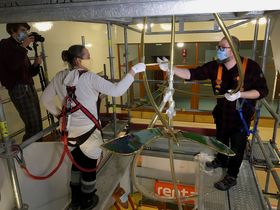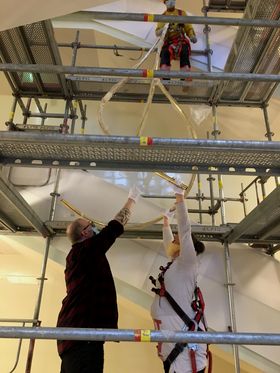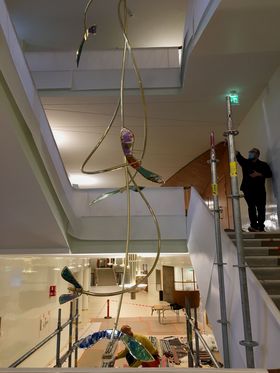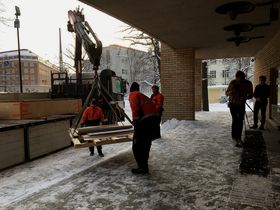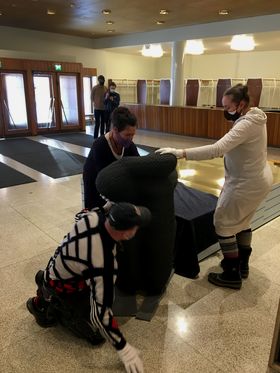Radical Nature
Radical Creativity art collection in Töölö
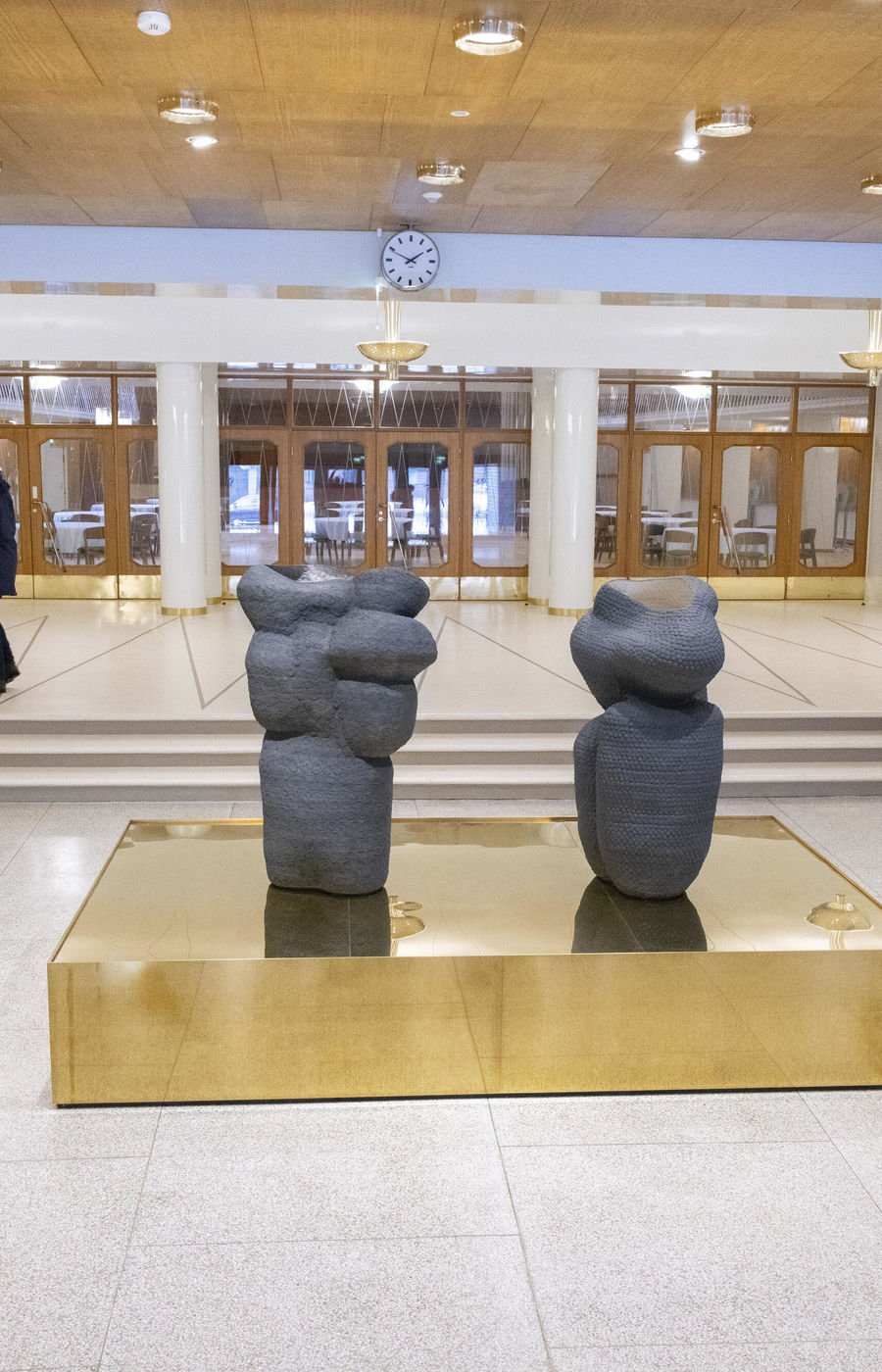
Celebration of materiality in AaltoUniversity Töölö art
What kind of art works does a remarkable historical building in the centre of Helsinki need? It is a building with so many stories, memories, and a strong, unique architecture. The art works are to be situated in a historical atmosphere, so they need to respect the past. Furthermore, they need to also provide ideas for new thinking, proposing diverse angles for the future. Rethinking and reimagining are at the core of both art and the university. An art work in the university can act as an inspiring impulse in finding the right (or wrong) questions in learning or research. The art works create respect for the past, yet they encourage our gaze into the fu- ture with radical creativity. The art works propose a question: can radical creativity be seen as something growing from the learnings of our past?
The ceramic relief ‘Merchants’ at the façade of the building by Mikael Schilkin is well-known since its completion in 1950. Schilkin (1900-1962) worked at the Arabia art department and incidentally also the present major artworks in the building are made by artists, who at the moment work at the Arabia Art Department. Both artists Kristina Riska and Sa- kari Kannosto work with a strong connection with materiality. Riska’s big ceramic sculptures are master pieces that create a strong contrast to the main lobby at Aalto Töölö. A custom-made brass covered pedestal celebrates the materials of the building and lifts the artworks in the space. Kannosto’s hanging art piece in the staircase proposes various viewpoints for the viewer circulating in the staircases with brass stems and colored glass-seed cosmoses. Both public art works in the Aalto University art collection celebrate materiality, which lasts for decades, similarly as in the materials in this historical building. The art works react to caringly renovated historical spaces, where both the lobby and the staircases are defined by the actions of entering and leaving.
The decisions of the artworks were made by a jury including Aalto University's Vice President for Research Ossi Naukkarinen, Aalto Univer- sity Board Vice Chair and Director General at Nationalmuseum, Sweden, Susanna Pettersson, independent art critic, gallerist and curator Veikko Halmetoja and CEO of Aalto University Executive Education and Professor of Practice at the Aalto University School of Business Pekka Mattila. Aalto University's Art Coordinator Outi Turpeinen coordinated the public art projects.
Outi Turpeinen, Senior Specialist, art & exhibitions
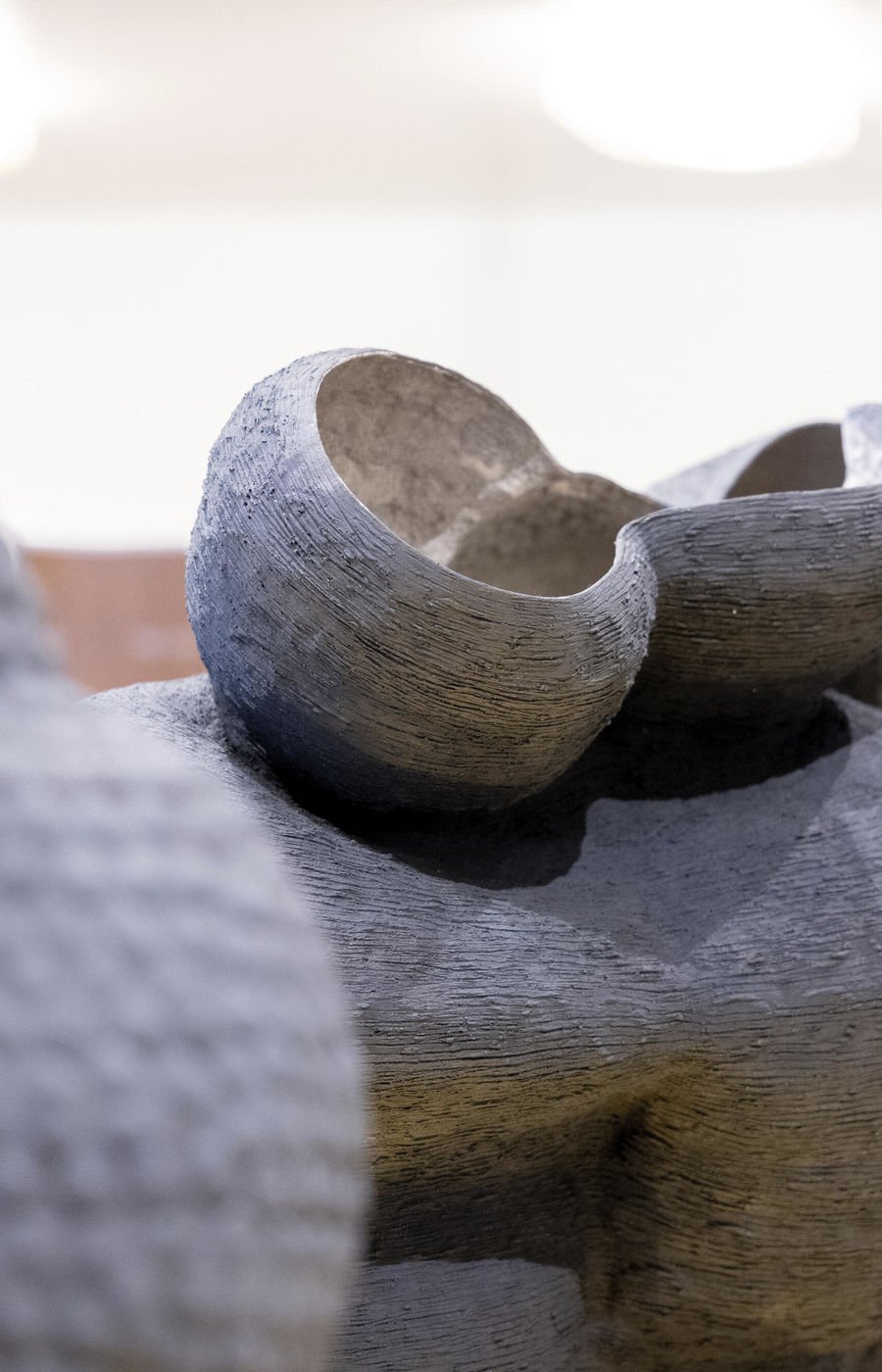
How to be bare?
The impressive sculptures by the artist Kristina Riska are hand-made with great skill. First, she starts with a hand-drawn sketch. Then the slow building process begins, where clay is added layer after layer with bare hands. A special technique is developed while working with the same theme for over 35 years. The reason for making art for Riska is to find variations of the mental state of being a human being. For her, the search for honesty is equal to being bare. The art works are reminders of a continuous search for something which cannot be fully defined. The intention is to search for the core of bareness. “A grey winter scene is the landscape of the soul, where even ugly can be beautiful”. Where is the borderline between beautiful and ugly?
The bareness of the sculpture is visible in the big size and rough surfaces, which also prevent the sense of prettiness. Working alone with her big sculptures is challenging. Therefore, the sculptures are not only reminders of the size, but also of the limits and possibilities, of a human being. Being an artist is a constant push for boundaries years after years. “Maybe I have learned something during these years”, says the humble artist. Somehow the sense of time resonates in the big hollow artworks. The artworks stand as statements of patience in the search of bareness.
In Aalto Töölö, the art works are the center pieces in the entrance to the building. They create a strong contrast into the main lobby space with their blackness and materiality on a brass pedestal. When people are passing by the human-sized sculptures, the size of the people and the sculptures are equal.
Daily inspiration from movement
The art piece by Sakari Kannosto is like a jewel at the Aalto Töölö staircase. The gaze of the observer moves in the staircase around the sculpture, enabling various viewpoints. The art work portrays a simplified group of seeds of a Norwegian maple tree with shiny stems and colorful seeds.
The starting point for the idea of the art work came from the spatiality of the building. The organic round forms of the building with characteristic light designs by Paavo Tynell influenced the design of the artwork. The ‘Kiertää-Circle’ art work at Aalto Töölö seeks to honor the remarkable historical architecture and adds new layers of meanings. The work itself represents growth, ambition, courage, responsibility and the expectations of the new. Natural, yet simplified curvy shapes are creating movement with expressive color patterns and light. Visual tension as well as spatiality and movement are distinctive features to Kannosto’s art. The ‘Kiertää-Circle’ artwork at Aalto Töölö is a unique piece of art, which combine installation and materiality.
The glass wings of the seeds are made from recycled glass material from the Iittala glass factory. Every unique glass seed creates another kind of universe. The stems together with the seeds symbolize different fields of study. With his art piece Kannosto is asking: Can an artwork act as an everyday inspiration to the people working in the building? When people stop for a moment by the art work, can the variations of the expressive colors and different point of views inspire their own work?
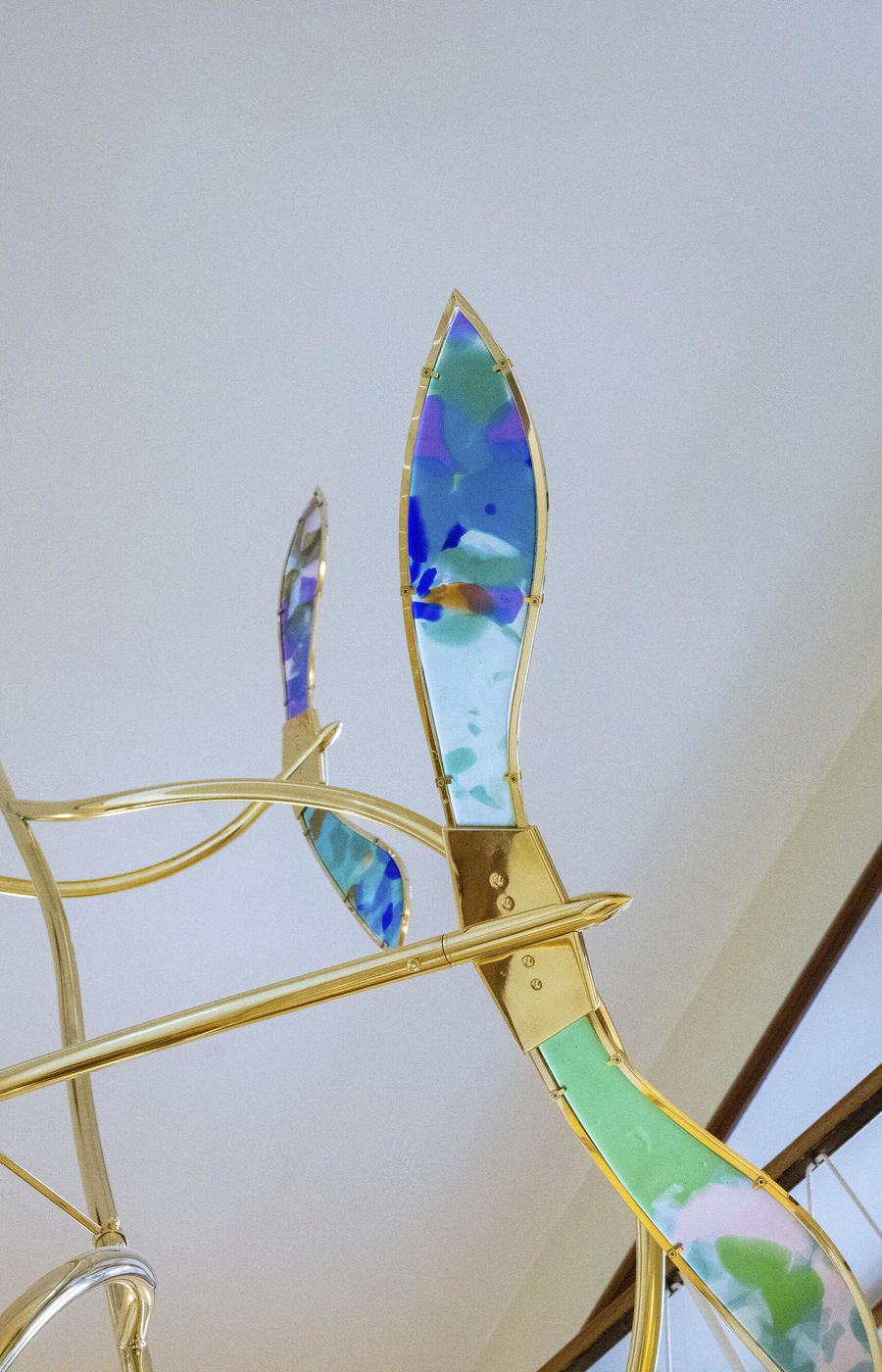
Creative Töölö
We are creative because we have to be. Creativity can be kindled by freedom but more often it is born out of necessity. While the world changes, we must follow. Most novel things we do are nothing extreme but tiny steps out of the conventional; some call that incremental creativity. It is rare to come up with a revolution or be radically creative. The most exorbitant cases are difficult to understand because they question our fundamental beliefs and values.
The legend says that the process behind creation is intuitive and not completely understood. That can make many academics feel doubtful as they are used to controlling every step of their work. But both aspects – intuition and control – are needed if we want to achieve anything.
Universities should be environments where we are not afraid of trying out the most extraordinary ideas in discussions, labs, workshops and publications – not just by loosely jotting down wild guesses but persistently chasing something that is better than what we now have. Universities have been good at this: there are few other institutions that over hundreds of years have adapted them- selves to all kinds of surroundings and repeatedly changed our understanding of the whole world.
Art is often considered to be the prime area for new insights. Visiting almost any art exhibition or concert hall proves the contrary. Artist are quite as conservative as anyone else.
However, artist typically work differently from academics, and art students are encouraged to be experimental and find their own viewpoints. That is not easy, and the ultra-modernistic dream of overcoming the previous generations can wax into a paralyzing nightmare.But this does not have to happen. When artists, scientists and other academics are brought together, teamed up with non-aca- demics and when everyone’s courage, open mind and creativity is respected, we may see something unexpected growing – in Aalto Töölö as elsewhere.
Ossi Naukkarinen, Vice President/Aalto University
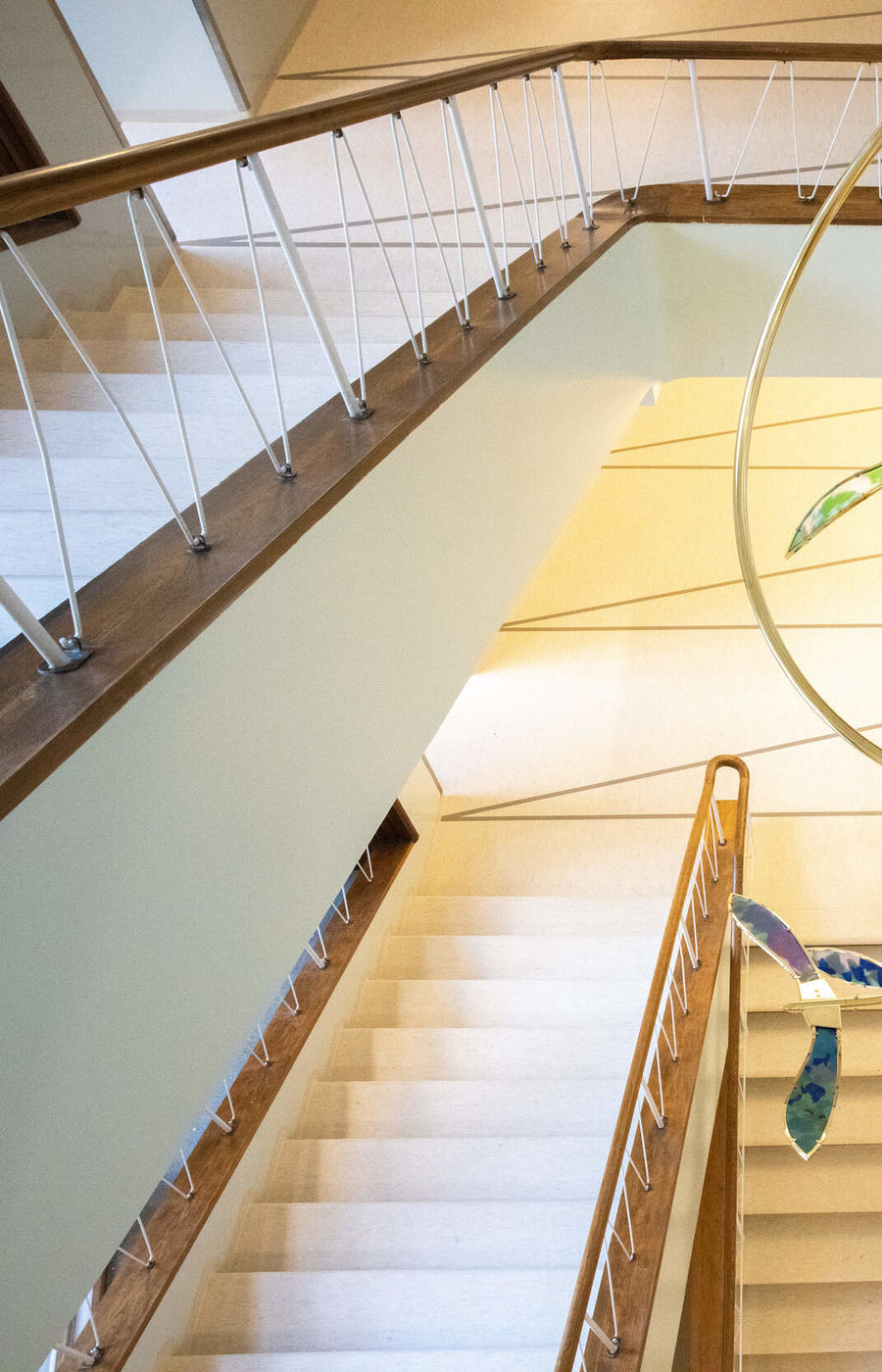
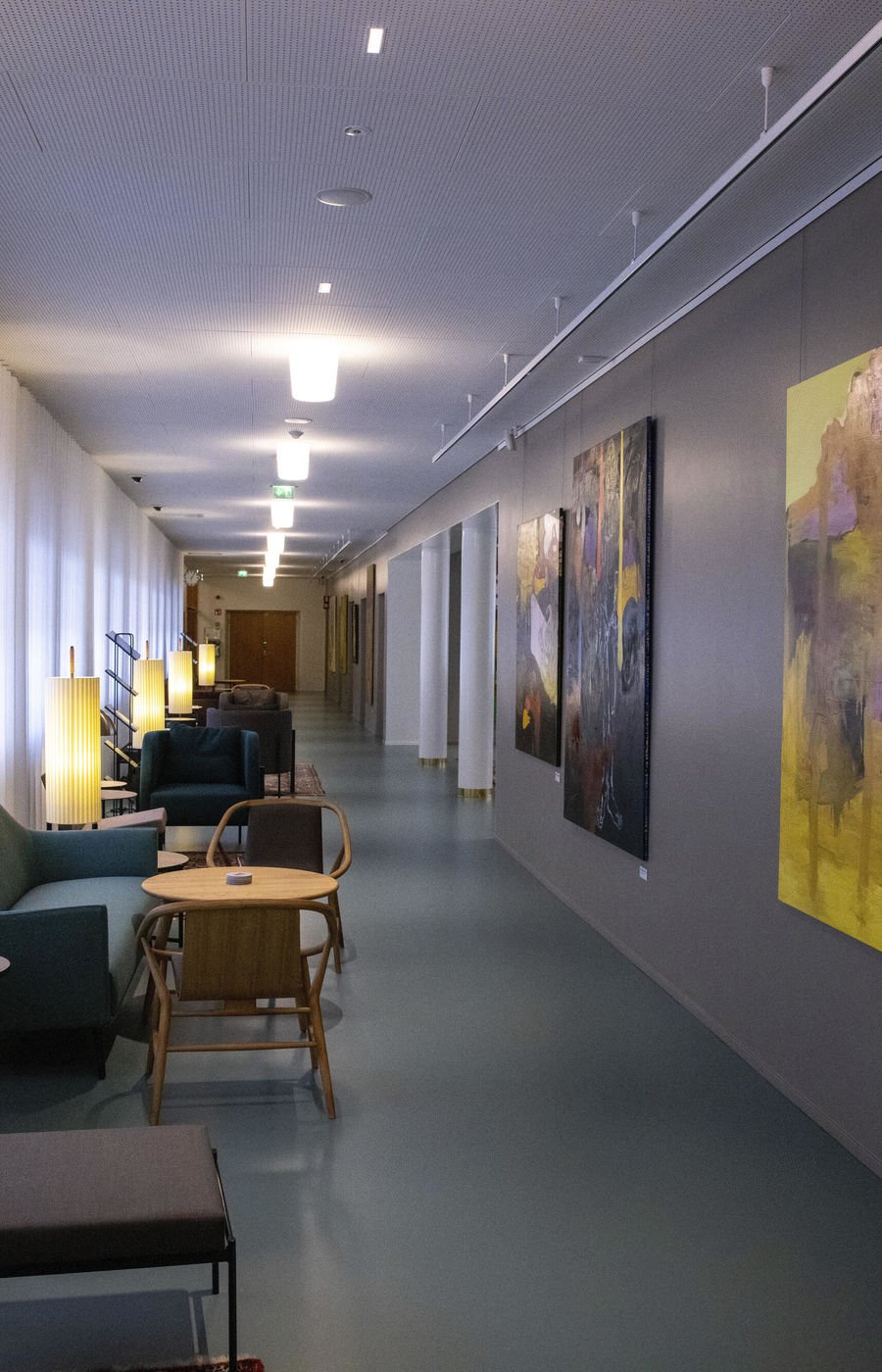
Art opens the mind to new possibilities
The art collection on display at Aalto University Executive Education comprises some 300 works, representing modern and contemporary art. Our premises offer customers and employees a safe environment to encounter art. Museums and galleries can feel intimidating for a beginner, but in a space meant primarily for something else, in our case learning or working, you can take your time with the works on show, return to them time and time again, and come up with your own interpretations.
There are three reasons why we need art at an educational institution.
First, art awakens the senses, opens the heart and mind to new ideas, and forces us to encounter the unknown. It fuels our ability to understand different interpretations and meanings, which is paramount for learning to take place, particularly in social and behavioral sciences.
Second, art evokes emotional responses. Unlike managerial concepts, such as divergence or convergence, art draws out the primitive in us. It makes us feel, whether it’s delight, wonderment, or disgust, and steers us away from professional jargon, towards the real world.
Third, art functions as a communication system. It conveys a message of who we are and what we value. Art can also act as a catalyst, a safe topic in getting acquainted and forming relationships with new colleagues or fellow program participants.
In the end, however, art should not have to justify itself. It would be a grave mistake to imply that the meaning of art lies solely on its effects on learning or wellbeing. To me, the purpose of displaying art at the premises is not to produce immediate, measurable results. As any home, a good learning and working environment also contains objects with no practical function; often, they are the ones that we remember the best and value the most.
Pekka Mattila, Professor of Practice/Aalto University School of Business
